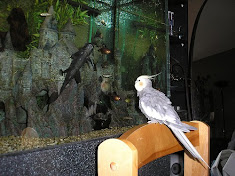 |
| Red Iguana Munching Down by Amanda Lockwood |
The common type of iguana is muscular with its legs like frogs. They possess multi jointed delicate toes that make them climb easily. They have exceedingly sharp claws. The crest on the back of males is heavier than female iguanas. They have a wide mouth and sharp teeth, short nostrils and exterior ear drums. Iguanas have a third eye also at top of head, which watches the movements over the head.
Red Sided Skink iguanas also have a third eye. This variety of iguana is mostly found in rocky plains of Eastern and Southern Africa. These have lengths up to eight inches and they lay the eggs like other iguanas. They are also cold blooded and easily adjust to their environment.
These iguanas are insectivores and eat mealworm. They also like crickets coated with powder containing calcium and vitamins. They should be fed dark green leafy vegetables, fruits and clean water.
The Red iguanas belong to terrestrial category and spend time in search of food within a short distance from their domicile. They cannot travel long to find any other suitable dwelling place as they easily get disjointed.
The female red iguanas lay eggs in burrows dug by them in hot sunny areas. They cover their eggs and leave them unguarded. The eggs get hatched themselves because of warmth of steady temperature between 77 and 89 degrees Fahrenheit. All eggs get hatched simultaneously. Young iguanas come out of the tunnel themselves.
Iguana males are very invasive towards other males when they do courtship. But otherwise, they are calm and fearful and run away, if you go nearer to them. These species are gradually getting endangered. Those found abundantly in wild earlier are getting vanished. The major causes are cutting of forests. Consequently, they lose the place to live. Moreover, they fall a prey to animals and human beings also eat them in many islands.
However, it is possible to take some suitable steps to avoid their extinction. These measures may include enforcing anti-hunting laws, boosting up their captive generation in zoos, educating the people in the iguana inhabited areas to protect them.
Many Americans are keeping them as pets. This may also help these animals from getting imperiled.
Author Resource: Written by David Peterson
For more information on Iguanas go to Jinga's Pet Article World.
Article From Pet Article World



0 comments:
Post a Comment